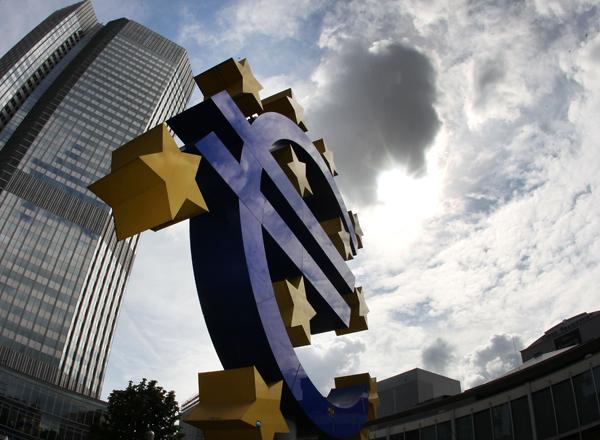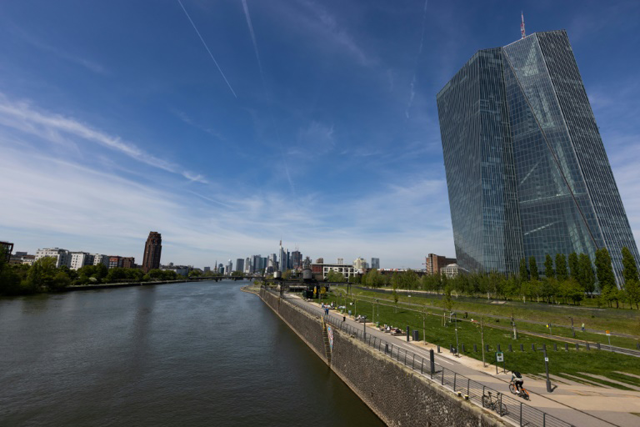You are here
Eurozone economy regains size of 2008 but remains shaky
By AP - Apr 30,2016 - Last updated at Apr 30,2016

This July 31, 2012 file photo shows the euro sculpture in front of the headquarters of the European Central Bank in Frankfurt, Germany (AP photo)
LONDON — It's been a long and tortuous journey, but the eurozone economy is finally back to the size it was before the global financial crisis.
The 19-country currency union, which is as a bloc the world's second-largest economy, enjoyed an unexpected acceleration in the first three months of the year, when it expanded by a quarterly rate of 0.6 per cent, official figures showed on Friday.
That's twice the previous quarter's rate and means the economy is now bigger than it was at the start of 2008, before the financial crisis triggered the deepest global recession since World War II.
While the size of the eurozone economy has recovered, however, the region still has far to go to heal fully.
That's most evident in the unemployment rate, which dipped to 10.2 per cent in March but is still 3 per centage points higher than it was in 2008. The jobs problem remains particularly acute in countries like Greece and Spain that suffered the most financially. They have unemployment above 20 per cent and about half of young jobseekers can't get work.
Meanwhile, inflation is way too low for a healthy economy, and the banks in many countries are still burdened with bad loans that keep them from lending.
Since 2008, the eurozone has had a torrid time, falling in and out of recession as the global financial crisis morphed into a regional debt crisis that at various times threatened the future of the euro currency itself. As the region bailed out Greece and several other member states and required governments to make painful budget cuts, its economy struggled to get back on track.
By contrast, other economies like the US and Britain recovered steadily. The US, for example, regained its pre-recession size back in 2011 and has seen unemployment fall sharply.
The acceleration in the eurozone's growth in the first quarter of this year may be the clearest indication yet that the region is finally moving into a higher gear — particularly as it came during a period of high global uncertainty. Financial markets were volatile due to worries that the Chinese economy would slow down sharply, dragging down global growth, and the price of oil tumbled to 12-year lows, raising concerns about the energy industry.
The eurozone's first-quarter growth rate — reported by statistics agency Eurostat on Friday alongside the unemployment figure — was above market expectations for a 0.4 per cent gain. The annualised rate of about 2.5 per cent is way more than the US equivalent of 0.5 per cent in the same period.
Though no details were offered beyond the headline numbers, it seems that the eurozone — a net importer of crude — has benefited from the fall in oil prices. The fall in the value of the euro has also helped the region's exporters, particularly in Germany. The European Central Bank's (ECB) monetary stimulus measures appear to be helping to boost lending, which is vital to business activity and growth. And governments are less focused on budget cutbacks that tend to weigh on growth.
Whether the economy will keep expanding at this rate will depend on a number of factors, many of which are external to the eurozone, such as the British vote on June 23 on whether to leave the European Union and China's performance. Within the eurozone, worries over Greece's future in the single currency bloc could flare up again and the upcoming Spanish general election may cause jitters.
"False dawns have been common since the financial crisis and nowhere more so than in Europe," cautioned Alasdair Cavalla, senior economist at the Centre for Economics and Business Research.
Though the growth and unemployment figures are on the right path, the lack of inflation remains a problem.
Eurostat said that consumer prices in the year to April fell by 0.2 per cent. That's down from the previous month's annual rate of zero and below market expectations for a more modest decline to minus 0.1 per cent. The core rate, which strips out the volatile items of food, alcohol, tobacco and energy, also declined, to 0.8 per cent from 1 per cent.
That will be disappointing for the ECB, whose primary policy aim is to keep inflation just below 2 per cent.
As a result, the market reaction to Friday's data was muted. While the growth and unemployment figures may have encouraged traders to think that the ECB will be less likely to enact a further stimulus, the inflation data suggest the opposite. The euro was steady just below $1.14 following the data.
The ECB is worried that low or subzero inflation could lead to deflation, a long-term drop in prices that can choke the life out of an economy for years. That's the primary reason why it's cut its interest rates, including its main one to zero, and launched a bond-buying programme that it hopes will stoke economic activity and lift prices in the longer-term.
No further stimulus is expected from the ECB soon but if prices keep falling for longer than anticipated, then it could be forced to act again. The ECB expects prices to start picking up soon, partly because of its stimulus programmes but also because of the recent pick-up in oil prices, which should lead to higher energy bills and prices at the pump.
Tomas Holinka, an economist at Moody's Analytics, thinks that higher eurozone growth will be one reason why inflation "should return to positive territory in the second half of the year".
Related Articles
BRUSSELS — Economic growth in the eurozone contracted in the third quarter, data showed on Tuesday, hit by the European Central Bank's (ECB'
BRUSSELS — Sliding energy prices helped lower eurozone inflation more than expected in May but underlying pressures suggest the European Cen
BRUSSELS — Eurozone inflation remained unchanged in August, official data showed on Thursday, leaving the European Central Bank (ECB) faced












